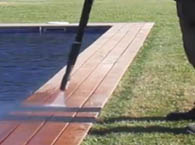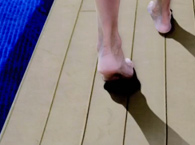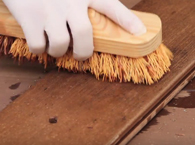Video gallery
Doubts about...
What is a wood stain?
Is a wood stain the same as a varnish?
No, a wood stain is a covering with impregnating action which does not form a coat, and has an “open-pore” finish which regulates humidity in the wood and allows moisture from the interior to escape.
What are the advantages of a wood stain?
Outdoors wood is exposed to environmental changes. If the protector is to adapt to these changes, one of its features will need to be flexibility in its resins. This characteristic will allow it to adapt to dimensional variations in the wood. This is achieved with wood stains. The use of varnishes, with their film-like finish, is only advisable for indoors. The use of varnishes for exteriors implies the risk of cracking and consequent peeling of the product. What is more, wood stains provide total protection for the wood
Is it true that water-based wood stains offer less resistance outdoors?
Completely wrong. Water is the vehicle used for depositing the different components in the wood stain formula, which are the very ones that protect the wood, showing excellent results for exteriors.
Can I mix two wood stains?
Yes, provided they are recommended for the same type of wood. We at CEDRIA offer many product tandems which, blended or combined, produce extraordinary results. On the descriptive file of each product you will find the ideal complement.
Can a wood stain have a gloss finish? And colour?
Of course. It’s just a question of choosing the right product. CEDRIA SOL LASUR is an example of a gloss finish. In the colour wood stain section we find CEDRIA DEKOR LASUR.
How much wood stain do I need for a surface of 10 square metres?
Our products have a coverage ranging from 9 to 14 square metres per litre. Consult the coverage calculator for each product and don’t forget to multiply the result by the number of coats you intend to apply.
Does a special kind of brush exist for wood stains?
For wood stains it’s best to use a flat, soft, acrylic bristle brush that does not shed hairs. For tropical woods neither roller nor spray-gun are recommended.
How long will a wood stain stand up to exterior exposure?
For any one product three key factors are at play: application, environment and wood type. A wood stain may last from one to three years, depending on those factors.
Does a wood stain have a fungicide effect?
The CEDRIA wood stains recommended for soft woods offer TOTAL PROTECTION. If you wish to take precautions and boost the fungicide and insecticide effect apply CEDRIA FONDO.
Is a wood stain finish similar to an oil finish? Or a wax finish?
A wood stain produces a very natural finish on wood, with a little more finish than an oil. Depending on our personal taste we can apply more or less finish to the wood. Beside each of our products there is a scale in which you can see the “thickness of the film”, which is an indicator of the quantity of transpirable finish created by each product.
Surfaces for application
Can a wood stain be applied to surfaces such as clay, cement or stone?
Yes, a wood stain is ideal for protecting and decorating all kinds of porous materials.
What is the difference between a primer or a wood stain for conifer wood and one for tropical wood?
Tropical wood is hard and difficult to impregnate, with a high content of greasy oils and tannins, and is very sensitive to the sun.
Pine wood is impregnable and prone to fungus.
Visit our wood section to apply the right product for each species
How can I know if the wood has already been treated?
Woods that are to be in contact with the ground need in-depth treatment. The appearance of a greenish shade on the wood indicates the presence of copper compounds, typical of autoclave treatment.
It is essential to apply a wood stain to defend the wood from the sun, preventing cracking and enhancing it with one of the colours available.
I’m having some new flooring installed and I am assured that the wood has already been treated. Should I apply anything else to the wood?
Tropical wood flooring is normally pre-treated with oil. It is advisable, once the floor has been installed, to clean it with a hydro cleaner and apply a suitable product to offer longer durability and enhance the appearance of your new floor. Visit the “products” section.
Can you apply a wood stain on non solid wood such as plywood?
Of course, these woods should be treated as if they were solid wood.
How does the moisture content in new wood affect the application of a wood stain?
In new woods the moisture content should not be over 18-20%, to guarantee that the wood does not crack..
The wood stain contributes to what is called hydro/hydric-balance in the wood, which is to say, the natural regulation of water content in the wood.
What process should we follow in woods with a low impregnability level, such as fir?
On those woods you should apply first the colour (CEDRIA DEKOR LASUR) followed by the primer (CEDRIA FONDO) and then the finish (CEDRIA SOL LASUR or CEDRIA BARNI SOL) if a higher finish is required.
How can black tannin stains be avoided on woods such as Oak or Chestnut,...?
If the wood shows tannin stains it should be sanded and then one coat of CEDRIA FONDO BLOQUEA LOS TANINOS should be applied to all surfaces to prevent the reappearance of black stains caused by tannins.
For tropical woods, is oil the best solution?
It’s a quick, common option, but nowadays there are other alternatives such as wood stains, which prolong beauty and durability in the finish.
On a porch which does not receive direct sunlight is it better to apply a wood stain or a varnish?
If it is not directly exposed to sun or rain, a coloured or neutral varnish may be applied.
On exteriors receiving direct sunlight it is essential to apply coloured wood stains to reinforce solar protection from the solar filters. A neutral wood stain would provide insufficient resistance to U.V. rays.
Can I use a wood stain on boats and water-craft?
Yes, provided the surface to be covered is not in permanent contact with the water.
Can I use a wood stain on a beach house?
Yes, although you should bear in mind that the erosive action of sand particles and salt carried by the wind in coastal areas will wear down and erode the surfaces more quickly, so periods between refreshing will be shorter.
Application on exteriors
Can wood stain be applied in direct sunlight? And during extreme cold?
It is very important to avoid application in conditions of maximum solar radiation. As an emergency solution and to avoid the impact caused by rapid water evaporation, the wood should be constantly splashed with water.
Do not apply the products at temperatures below 5º.
Can the wood stain be applied on a rainy day? And at high humidity levels?
Before beginning an application it is important to make sure there is no threat of rain. The product should not be applied in the rain, nor at humidity levels of above 70%.
About sanding. Is any grain suitable for sanding wood in exteriors? Can an aluminium scourer be used?
Always sand in the direction of the grain of the wood. If the surface is horizontal (flooring), use a 40-60 grain sandpaper, and if it is vertical (walls, chairs…) 80 grain, so that the product can penetrate well. 100 grain sandpaper would have the opposite effect, in that it would not open the pores and we would lose penetration and adherence To sum up, our aim is to plane down, not polish.
Do not use an aluminium scourer as rust could develop in any particles that may get encrusted in the wood
Can a hydro cleaner. be used instead of sanding?
The hydro cleaner can complement the sanding by eliminating the dust, leaving the wood clean, or be used instead of sanding, depending on the water pressure.
If it is used, the surface should be left to dry for 6 to 24 hours (depending on environmental humidity level) before following the process chosen.
Should a primer be applied before the finish? In which cases?
A primer is applied on new woods to intensify fungicide and insecticide treatment.
What is more, it evens out absorption rates in the wood and prevents high absorption.
Ideal for untreated woods exposed to the exterior.
Should water be added to the product before use?
Our wood stains are ready for use. Only for application by spray-gun or for interiors should they be diluted by no more than 5% preferably distilled water.
Brush, roller or spray-gun?
Use preferably a flat soft acrylic bristle brush that does not shed hairs.
On woods with low impregnation levels, such as tropical woods, rollers and spray-guns should be avoided.
Is it compatible to apply a water-based wood stain and finish with a dissolvent-based product, or vice-versa?
Yes, provided thorough drying of the previous coat is assured.
As a safety measure we recommend doing a test before the application proper.
If I apply four coats of wood stain, will it last longer? What is the limit?
Excessive doses are damaging. We recommend applying the dosage marked on the tin. Apply correctly following the instructions and do not forget to protect all edges on doors and windows.
Should a wood stain be sanded between coats when applied in exteriors?
Sanding between coats is not recommended as it reduces doses of the product. If a finer finish is required, sand just before the last coat.
How should brushes be cleaned after applying a water-based wood stain?
With water. However, necessary measures should be taken to protect the environment. Avoid pouring into rivers and river beds.
Should the wood be sealed before applying a CEDRIA gloss paint?
This is not necessary, although an application of CEDRIA SELLADORA sealer (micro porous) guarantees a more even finish on gloss surfaces both for interiors and exteriors.
Maintenance
How frequently should a wood stain be refreshed?
Durability varies according to the type of exposure to which the wood is submitted. Horizontal exposure requires the most frequent refreshment.
Can I use a hydro cleaner to clean a surface on which a wood stain has been applied?
Yes, but we recommend using low pressure and no more than once a month.
When applying a refresher coat, is it necessary to completely remove the previous wood stain?
The simplest way is to clean the surface with a hydro cleaner, using medium pressure so as not to damage the coats of wood stain.
Allow to dry between 6 and 24 hours and apply the refresher coat.
To avoid excessive pigmentation of the wood, mix the colour wood stain with 50% neutral.
Application in interiors
Can I apply a primer for new woods in interiors?
Yes, for internal protection of the wood.
Should I seal the wood before applying a CEDRIA varnish or wood stain?
Applying CEDRIA SELLADORA (micro porous) guarantees a more uniform finish on surfaces to be glossed both indoors and outdoors.
For a good varnish in interiors use CEDRIA TAPAPOROS, to close the pores with optimum results.
Can I apply a wood stain in interiors?
Yes, this is possible and you will obtain a natural finish which, when sanded between coats, will produce a wax-like finish.
For flooring we recommend using CEDRIA PARQUET ESCALERAS, providing optimum resistance to knocks and scratches.
Is it possible to apply a water-based wood stain on a varnished surface?
Varnish forms a film. Before applying a wood stain you will need to sand or strip off this film.
If I wish to add colour to interior wood, which product should I use?
If you wish to apply a varnish, you can apply CEDRIA BARNIZ INTERIORES – CON COLOR.
If you wish to apply a wood stain and the wood is conifer or leafy, use CEDRIA DEKOR LASUR, and if the wood is tropical use CEDRIA FON TIN primer. After you can apply a CEDRIA varnish to increase durability of the finish.
Can I apply CEDRIA varnish in a room without windows?
Lack of ventilation is a determinant factor when choosing a product. Our varnishes are water-based and offer the most technologically advanced solution for minimising risks in closed rooms. They are odourless and very quick-drying.
What are the advantages of a varnish over a wood stain?
Varnishes are ideal for interiors when the wood requires a polished finish and mechanical resistance to abrasion.
 CLIENT AREA
CLIENT AREA


























